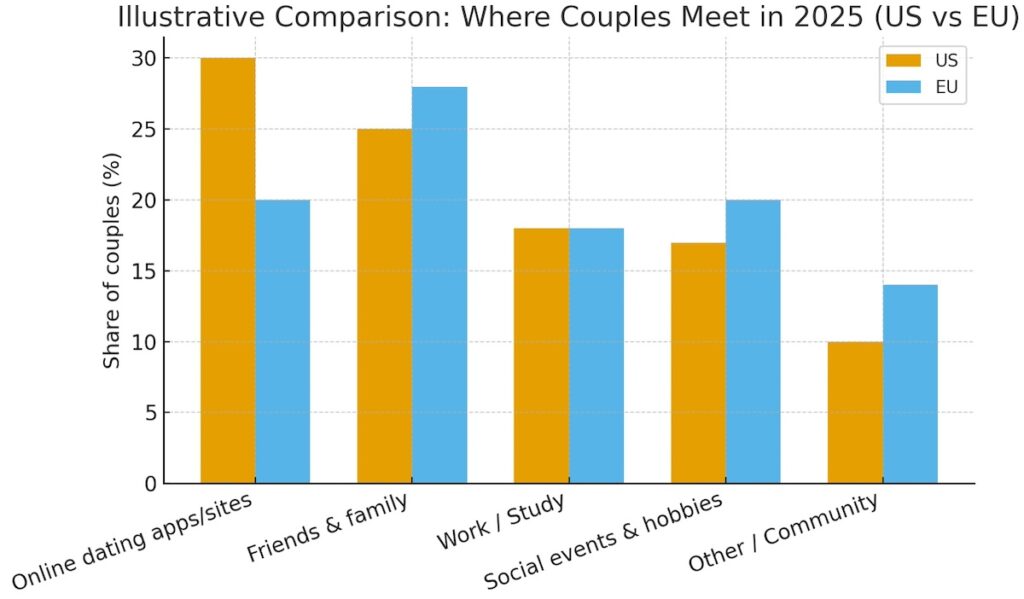In 2025, meeting someone new isn’t “online vs offline” anymore. It’s one blended system: apps, friends, work, hobbies, Instagram, random real-life moments—all talking to each other. In both the US and the EU, people pick channels the way they pick outfits: depending on mood, age, city size, goals, and how much emotional energy they’ve got left that week.
Here’s a clear, human overview of where relationships actually start now, with numbers added directly instead of any graphic blocks.
1. The Big Picture
Three core truths:
- Online dating is completely normal. “We met on an app” is just a fact, not a confession.
- Offline routes are alive and well. Friends, family, work, uni, gyms, bars, communities—they never left.
- The mix depends on the region. The US leans a bit more into apps; Europe leans a bit more into social networks and everyday community.
Think of online as one more main doorway into the same emotional building.

2. United States: Apps as a Primary Door
For many Americans in their 20s–40s, especially in cities:
- Online dating website and app – about 30% of couples
Tinder, Bumble, Hinge, serious sites and niches: huge share of new relationships, especially for younger adults, LGBTQ+ users, and people in large metros. - Friends & family – about 25%
Introductions at dinners, parties, weddings, group trips, “you two should meet.” Still one of the most trusted and effective paths. - Work / Study – about 18%
Offices, hospitals, schools, service jobs, grad programs. Long shared hours plus familiarity = plenty of couples. - Social events & hobbies – about 17%
Gyms, clubs, sports, volunteering, music, classes—often organized or discovered online, but the spark happens in person. - Other / Community / Faith – about 10%
Local scenes, neighborhoods, religious communities, parenting groups. Smaller slice, but emotionally strong.
Typical US flow: match (or meet), quick screen on socials, low-pressure first date (coffee, drink, walk), then everything either quietly dies or quietly becomes “we.”
3. European Union: Balanced Channels
In the EU, the recipe is similar with different proportions:
- Friends & family – about 28%
Stronger role in many countries. Social circles, school friends, cousins, existing networks are active matchmakers. - Online dating apps/sites – about 20%
Very common in big cities and younger groups; slightly lower share overall than the US but growing steadily. - Work / Study – about 18%
Offices, universities, Erasmus programs, research labs, hospitality—people move around a lot and meet across borders. - Social events & hobbies – about 20%
Cafés, bars, festivals, football, climbing, dance, art, activist groups. Everyday culture is very social; lots of organic overlap. - Other / Community / Faith – about 14%
Villages, diaspora networks, cultural associations, religious communities—especially visible outside the biggest metros.
Many modern EU stories are hybrids: saw each other at an event, then connected on Instagram; or matched on an app, realized they share friends, then met at a bar or festival.
4. Summary Table
The table below pulls it together in one place. These figures are illustrative averages for 2025 to show the pattern, not country-by-country absolutes.
| Channel | US (%) | EU (%) |
| Online dating apps/sites | 30 | 20 |
| Friends & family | 25 | 28 |
| Work / Study | 18 | 18 |
| Social events & hobbies | 17 | 20 |
| Other / Community / Faith | 10 | 14 |
Reading it:
- US: online dating is slightly ahead, with friends/family close behind.
- EU: friends/family and social life lead, with apps as a strong second-tier channel.
- Everywhere: work/study and hobbies are quiet powerhouses.
5. How It Feels in Real Life
Underneath the numbers, the stories look very familiar:
- Someone in New York or London swipes, matches, checks Instagram, meets for a drink.
- Someone in Warsaw or Rome meets at a party through mutual friends, then messages on WhatsApp until the next night out.
- Two people in Berlin meet at a climbing gym, follow each other online, only later admit it’s a date.
- A cross-border couple starts with a language exchange, gaming server, or niche app, then turns that into flights and actual weekends together.
By 2025, the winning strategy for most people in the US and EU is mixed:
Use apps to expand options.
Use friends and community to filter.
Use real life to confirm.
And judge every channel not by its reputation, but by the one thing that still matters: how the person on the other end actually shows up when you’re sitting across from them, phones down.













